Construction in Practice 1: Sound Attenuating Window Systems Report
VerifiedAdded on 2022/09/18
|15
|2993
|22
Report
AI Summary
This report, submitted by a student, delves into the topic of sound attenuating window systems for residential buildings. It explores various techniques for noise reduction, including the use of close windows, double-glazed windows, and reducing window size with thicker glass. The report provides a detailed analysis of each technique, outlining installation costs, advantages, disadvantages, and environmental impacts. It also discusses the science of sound transmission through windows, emphasizing the importance of window design in managing noise pollution. The report includes graphical analysis and comparative assessments to provide a comprehensive understanding of sound attenuation strategies in construction. The report also covers the advantages and disadvantages of each technique including the environmental impacts of the materials used. The report is a practical assessment of technological improvements to the environmental performance of larger scale residential construction.
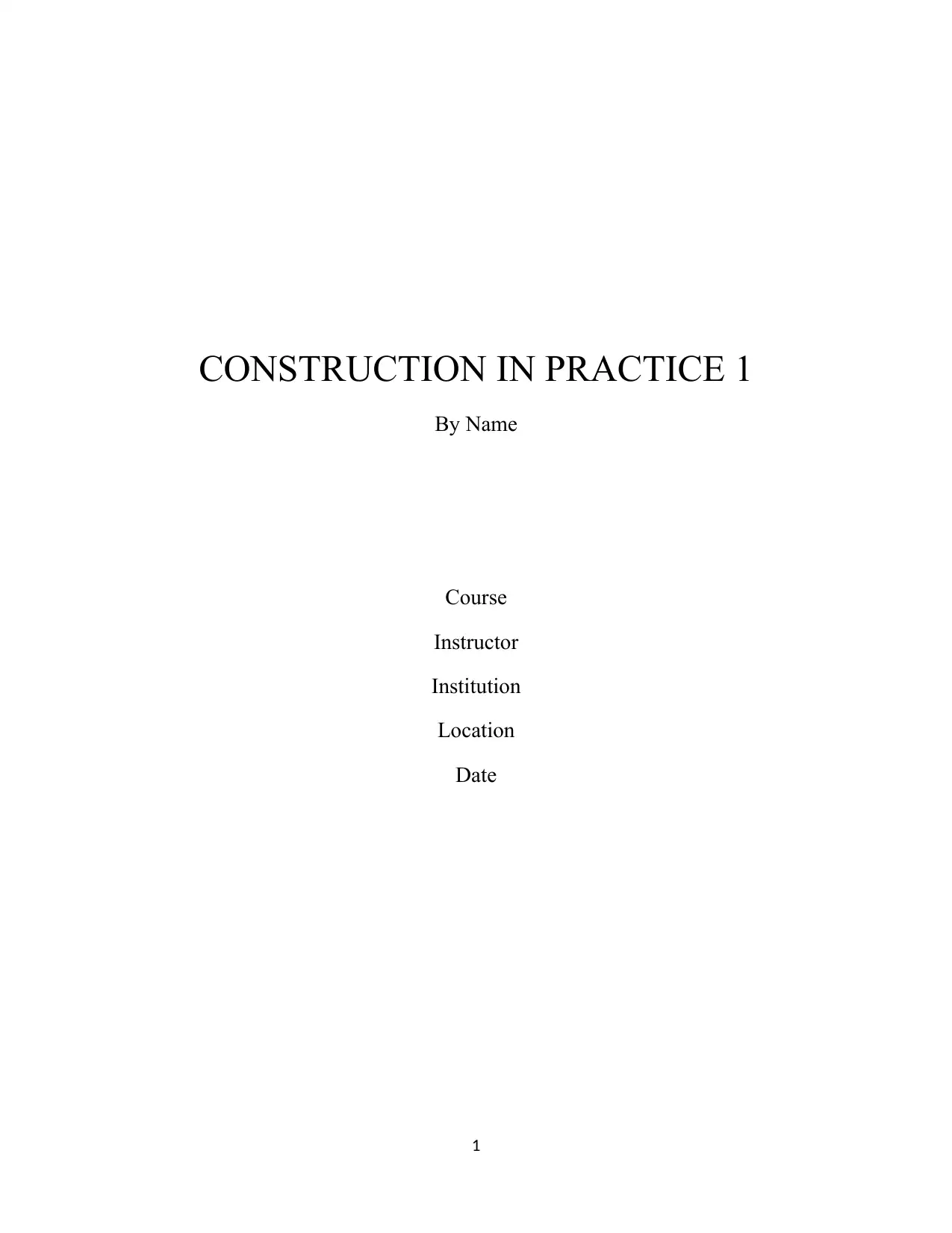
CONSTRUCTION IN PRACTICE 1
By Name
Course
Instructor
Institution
Location
Date
1
By Name
Course
Instructor
Institution
Location
Date
1
Paraphrase This Document
Need a fresh take? Get an instant paraphrase of this document with our AI Paraphraser
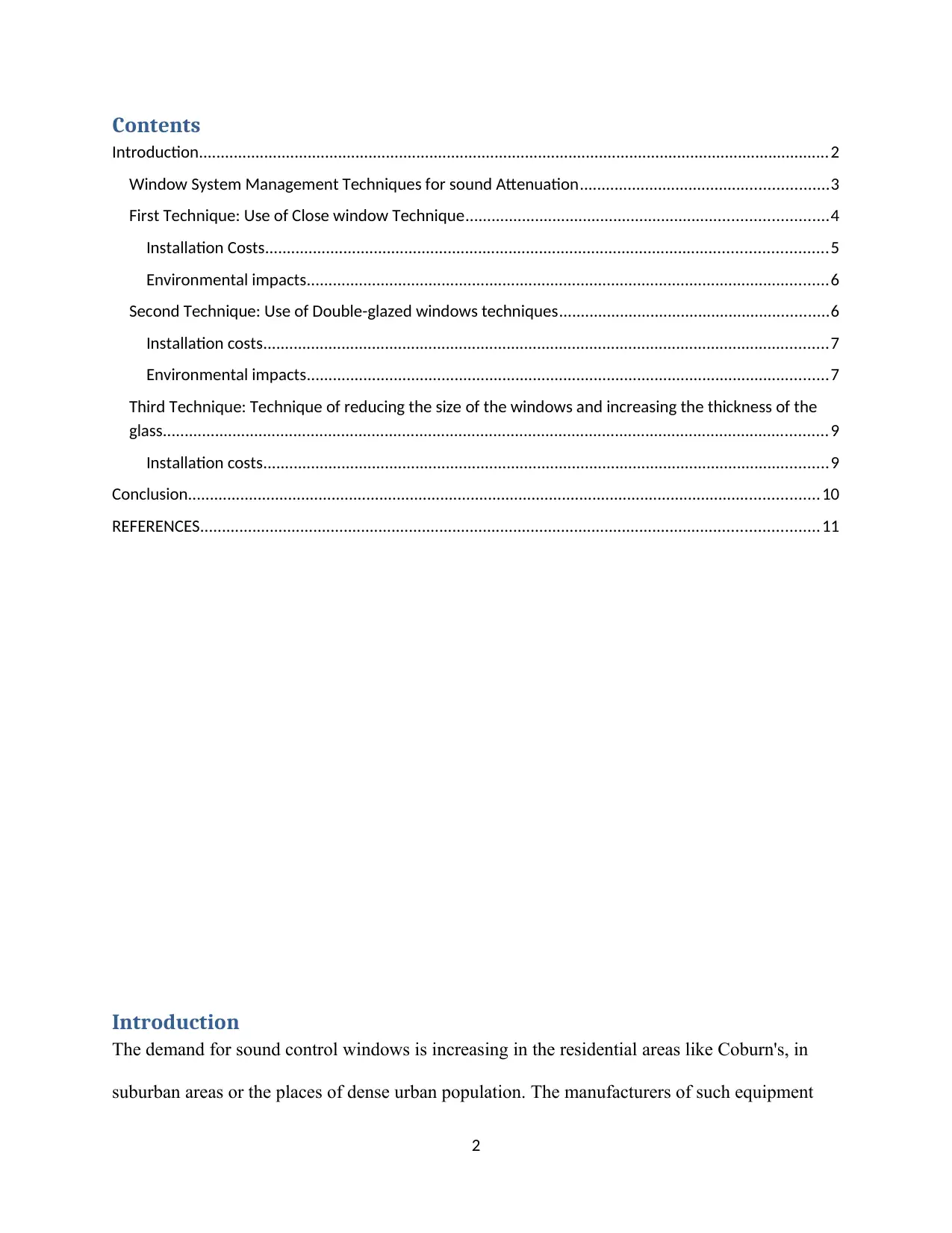
Contents
Introduction.................................................................................................................................................2
Window System Management Techniques for sound Attenuation.........................................................3
First Technique: Use of Close window Technique...................................................................................4
Installation Costs.................................................................................................................................5
Environmental impacts........................................................................................................................6
Second Technique: Use of Double-glazed windows techniques..............................................................6
Installation costs..................................................................................................................................7
Environmental impacts........................................................................................................................7
Third Technique: Technique of reducing the size of the windows and increasing the thickness of the
glass.........................................................................................................................................................9
Installation costs..................................................................................................................................9
Conclusion.................................................................................................................................................10
REFERENCES..............................................................................................................................................11
Introduction
The demand for sound control windows is increasing in the residential areas like Coburn's, in
suburban areas or the places of dense urban population. The manufacturers of such equipment
2
Introduction.................................................................................................................................................2
Window System Management Techniques for sound Attenuation.........................................................3
First Technique: Use of Close window Technique...................................................................................4
Installation Costs.................................................................................................................................5
Environmental impacts........................................................................................................................6
Second Technique: Use of Double-glazed windows techniques..............................................................6
Installation costs..................................................................................................................................7
Environmental impacts........................................................................................................................7
Third Technique: Technique of reducing the size of the windows and increasing the thickness of the
glass.........................................................................................................................................................9
Installation costs..................................................................................................................................9
Conclusion.................................................................................................................................................10
REFERENCES..............................................................................................................................................11
Introduction
The demand for sound control windows is increasing in the residential areas like Coburn's, in
suburban areas or the places of dense urban population. The manufacturers of such equipment
2
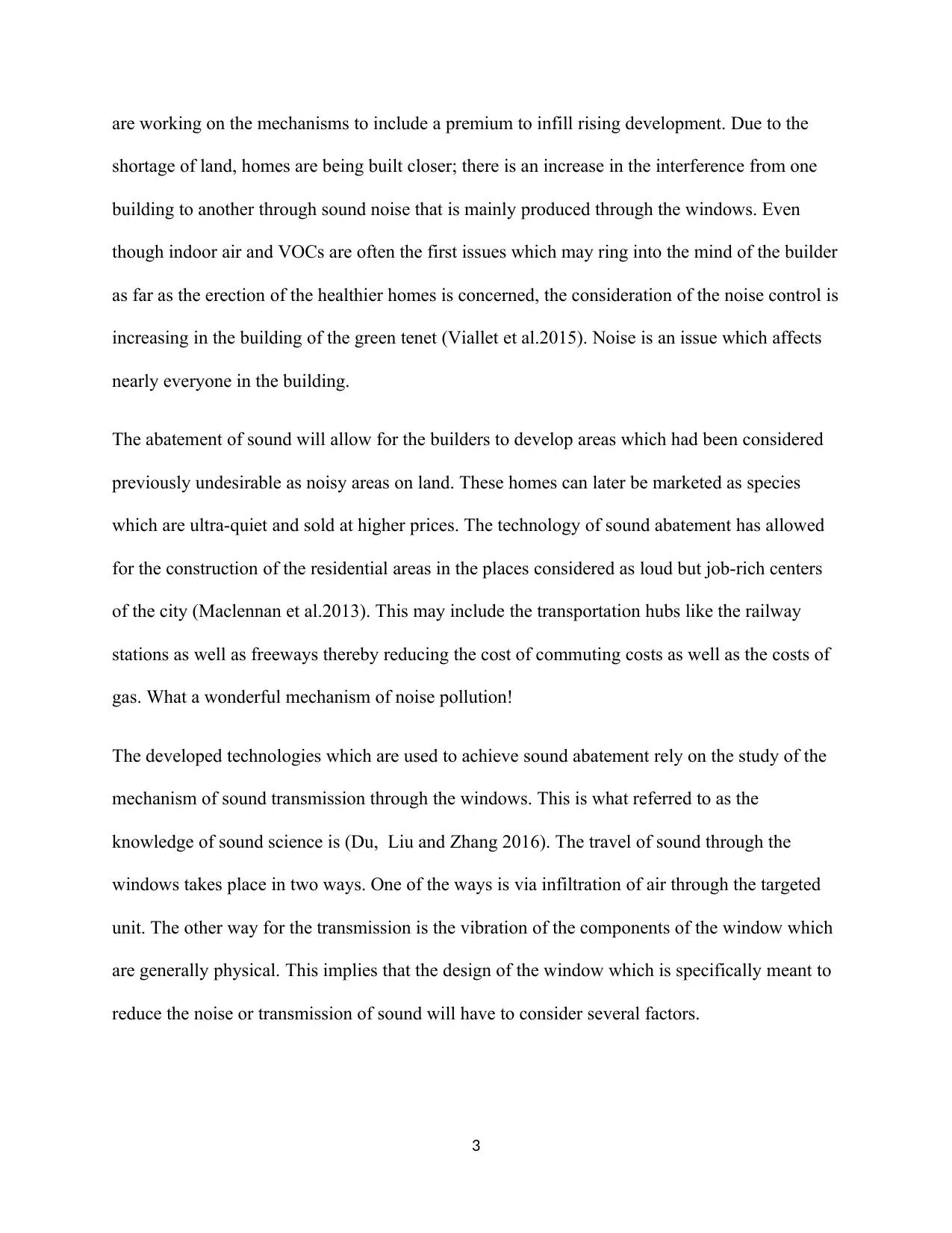
are working on the mechanisms to include a premium to infill rising development. Due to the
shortage of land, homes are being built closer; there is an increase in the interference from one
building to another through sound noise that is mainly produced through the windows. Even
though indoor air and VOCs are often the first issues which may ring into the mind of the builder
as far as the erection of the healthier homes is concerned, the consideration of the noise control is
increasing in the building of the green tenet (Viallet et al.2015). Noise is an issue which affects
nearly everyone in the building.
The abatement of sound will allow for the builders to develop areas which had been considered
previously undesirable as noisy areas on land. These homes can later be marketed as species
which are ultra-quiet and sold at higher prices. The technology of sound abatement has allowed
for the construction of the residential areas in the places considered as loud but job-rich centers
of the city (Maclennan et al.2013). This may include the transportation hubs like the railway
stations as well as freeways thereby reducing the cost of commuting costs as well as the costs of
gas. What a wonderful mechanism of noise pollution!
The developed technologies which are used to achieve sound abatement rely on the study of the
mechanism of sound transmission through the windows. This is what referred to as the
knowledge of sound science is (Du, Liu and Zhang 2016). The travel of sound through the
windows takes place in two ways. One of the ways is via infiltration of air through the targeted
unit. The other way for the transmission is the vibration of the components of the window which
are generally physical. This implies that the design of the window which is specifically meant to
reduce the noise or transmission of sound will have to consider several factors.
3
shortage of land, homes are being built closer; there is an increase in the interference from one
building to another through sound noise that is mainly produced through the windows. Even
though indoor air and VOCs are often the first issues which may ring into the mind of the builder
as far as the erection of the healthier homes is concerned, the consideration of the noise control is
increasing in the building of the green tenet (Viallet et al.2015). Noise is an issue which affects
nearly everyone in the building.
The abatement of sound will allow for the builders to develop areas which had been considered
previously undesirable as noisy areas on land. These homes can later be marketed as species
which are ultra-quiet and sold at higher prices. The technology of sound abatement has allowed
for the construction of the residential areas in the places considered as loud but job-rich centers
of the city (Maclennan et al.2013). This may include the transportation hubs like the railway
stations as well as freeways thereby reducing the cost of commuting costs as well as the costs of
gas. What a wonderful mechanism of noise pollution!
The developed technologies which are used to achieve sound abatement rely on the study of the
mechanism of sound transmission through the windows. This is what referred to as the
knowledge of sound science is (Du, Liu and Zhang 2016). The travel of sound through the
windows takes place in two ways. One of the ways is via infiltration of air through the targeted
unit. The other way for the transmission is the vibration of the components of the window which
are generally physical. This implies that the design of the window which is specifically meant to
reduce the noise or transmission of sound will have to consider several factors.
3
⊘ This is a preview!⊘
Do you want full access?
Subscribe today to unlock all pages.

Trusted by 1+ million students worldwide
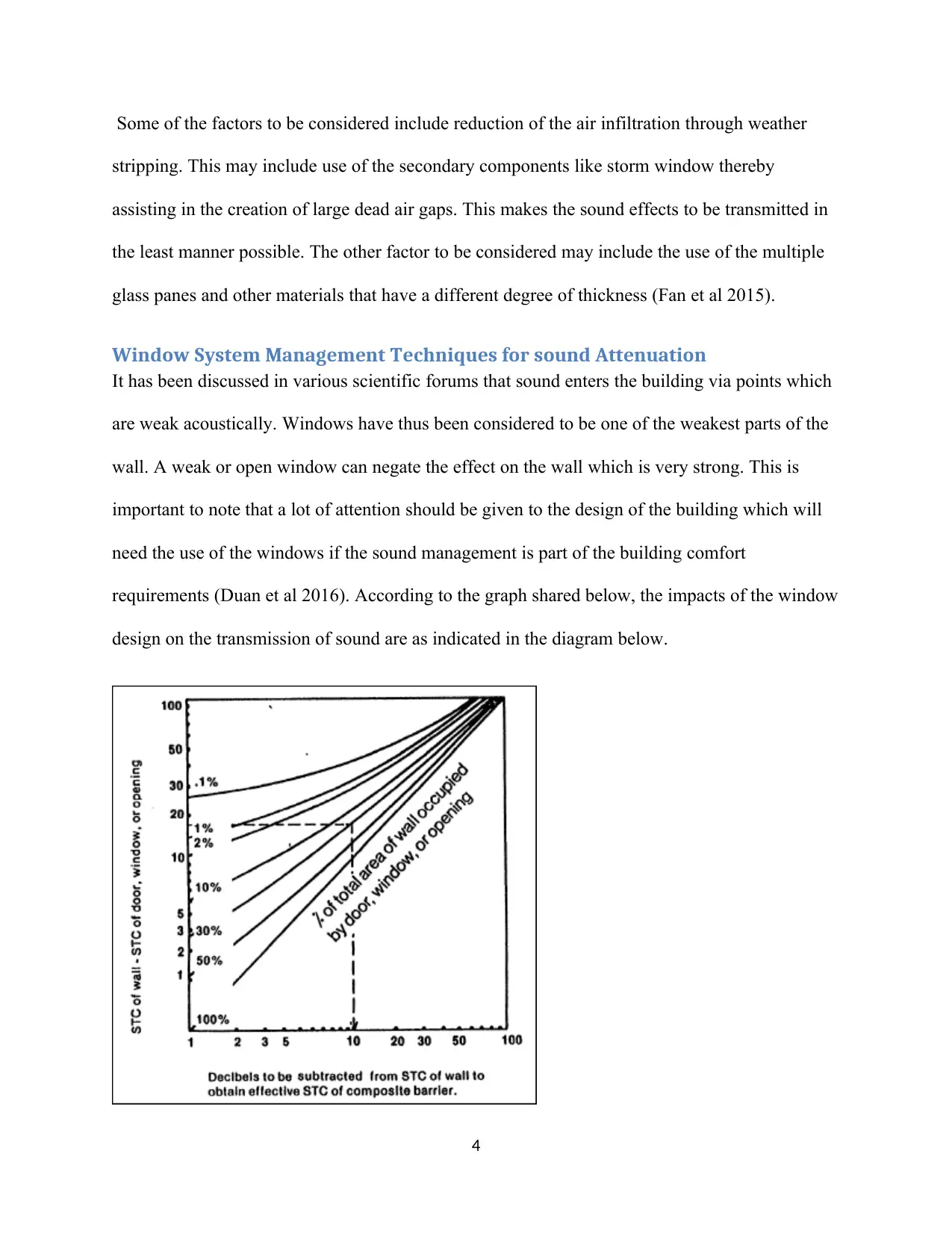
Some of the factors to be considered include reduction of the air infiltration through weather
stripping. This may include use of the secondary components like storm window thereby
assisting in the creation of large dead air gaps. This makes the sound effects to be transmitted in
the least manner possible. The other factor to be considered may include the use of the multiple
glass panes and other materials that have a different degree of thickness (Fan et al 2015).
Window System Management Techniques for sound Attenuation
It has been discussed in various scientific forums that sound enters the building via points which
are weak acoustically. Windows have thus been considered to be one of the weakest parts of the
wall. A weak or open window can negate the effect on the wall which is very strong. This is
important to note that a lot of attention should be given to the design of the building which will
need the use of the windows if the sound management is part of the building comfort
requirements (Duan et al 2016). According to the graph shared below, the impacts of the window
design on the transmission of sound are as indicated in the diagram below.
4
stripping. This may include use of the secondary components like storm window thereby
assisting in the creation of large dead air gaps. This makes the sound effects to be transmitted in
the least manner possible. The other factor to be considered may include the use of the multiple
glass panes and other materials that have a different degree of thickness (Fan et al 2015).
Window System Management Techniques for sound Attenuation
It has been discussed in various scientific forums that sound enters the building via points which
are weak acoustically. Windows have thus been considered to be one of the weakest parts of the
wall. A weak or open window can negate the effect on the wall which is very strong. This is
important to note that a lot of attention should be given to the design of the building which will
need the use of the windows if the sound management is part of the building comfort
requirements (Duan et al 2016). According to the graph shared below, the impacts of the window
design on the transmission of sound are as indicated in the diagram below.
4
Paraphrase This Document
Need a fresh take? Get an instant paraphrase of this document with our AI Paraphraser
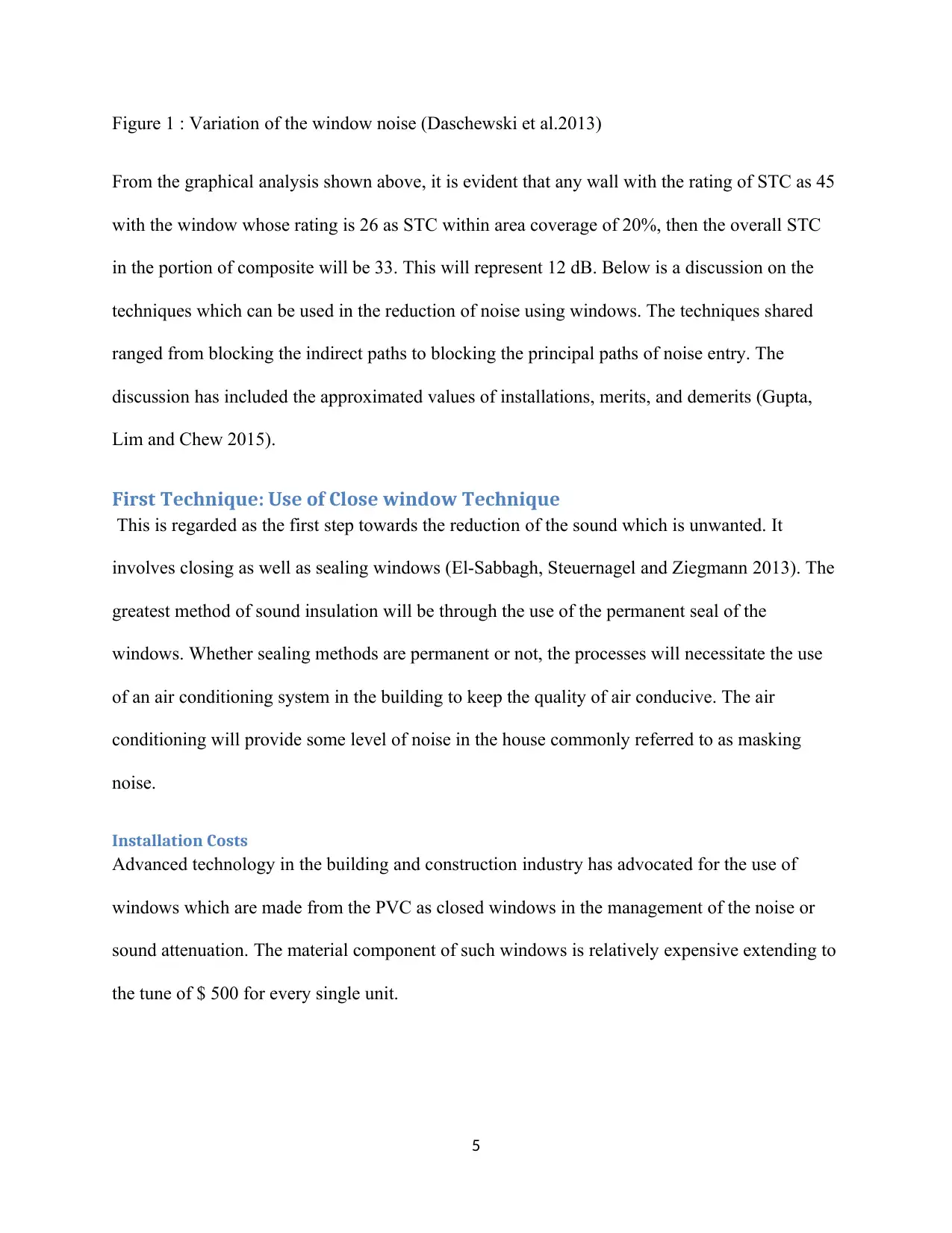
Figure 1 : Variation of the window noise (Daschewski et al.2013)
From the graphical analysis shown above, it is evident that any wall with the rating of STC as 45
with the window whose rating is 26 as STC within area coverage of 20%, then the overall STC
in the portion of composite will be 33. This will represent 12 dB. Below is a discussion on the
techniques which can be used in the reduction of noise using windows. The techniques shared
ranged from blocking the indirect paths to blocking the principal paths of noise entry. The
discussion has included the approximated values of installations, merits, and demerits (Gupta,
Lim and Chew 2015).
First Technique: Use of Close window Technique
This is regarded as the first step towards the reduction of the sound which is unwanted. It
involves closing as well as sealing windows (El-Sabbagh, Steuernagel and Ziegmann 2013). The
greatest method of sound insulation will be through the use of the permanent seal of the
windows. Whether sealing methods are permanent or not, the processes will necessitate the use
of an air conditioning system in the building to keep the quality of air conducive. The air
conditioning will provide some level of noise in the house commonly referred to as masking
noise.
Installation Costs
Advanced technology in the building and construction industry has advocated for the use of
windows which are made from the PVC as closed windows in the management of the noise or
sound attenuation. The material component of such windows is relatively expensive extending to
the tune of $ 500 for every single unit.
5
From the graphical analysis shown above, it is evident that any wall with the rating of STC as 45
with the window whose rating is 26 as STC within area coverage of 20%, then the overall STC
in the portion of composite will be 33. This will represent 12 dB. Below is a discussion on the
techniques which can be used in the reduction of noise using windows. The techniques shared
ranged from blocking the indirect paths to blocking the principal paths of noise entry. The
discussion has included the approximated values of installations, merits, and demerits (Gupta,
Lim and Chew 2015).
First Technique: Use of Close window Technique
This is regarded as the first step towards the reduction of the sound which is unwanted. It
involves closing as well as sealing windows (El-Sabbagh, Steuernagel and Ziegmann 2013). The
greatest method of sound insulation will be through the use of the permanent seal of the
windows. Whether sealing methods are permanent or not, the processes will necessitate the use
of an air conditioning system in the building to keep the quality of air conducive. The air
conditioning will provide some level of noise in the house commonly referred to as masking
noise.
Installation Costs
Advanced technology in the building and construction industry has advocated for the use of
windows which are made from the PVC as closed windows in the management of the noise or
sound attenuation. The material component of such windows is relatively expensive extending to
the tune of $ 500 for every single unit.
5
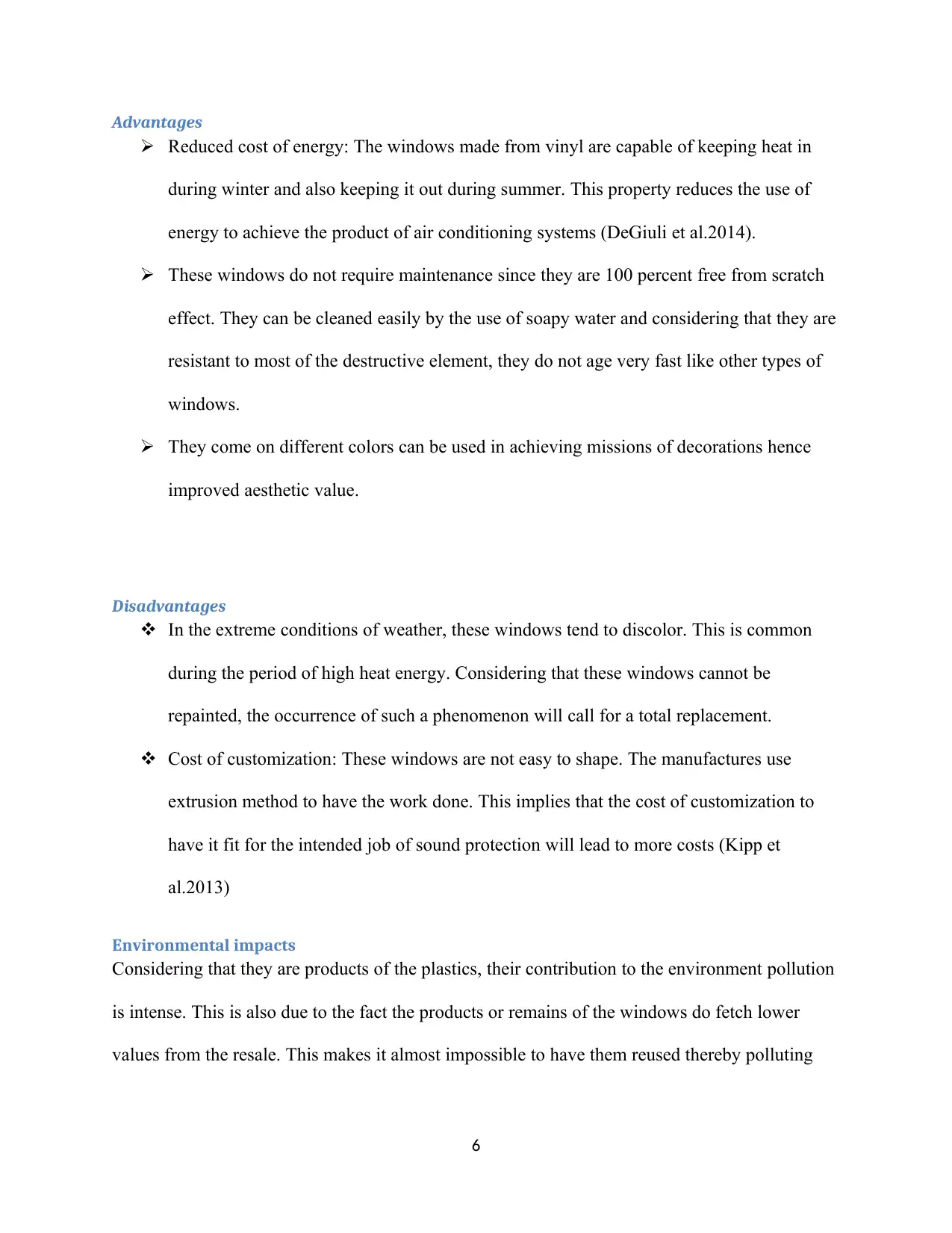
Advantages
Reduced cost of energy: The windows made from vinyl are capable of keeping heat in
during winter and also keeping it out during summer. This property reduces the use of
energy to achieve the product of air conditioning systems (DeGiuli et al.2014).
These windows do not require maintenance since they are 100 percent free from scratch
effect. They can be cleaned easily by the use of soapy water and considering that they are
resistant to most of the destructive element, they do not age very fast like other types of
windows.
They come on different colors can be used in achieving missions of decorations hence
improved aesthetic value.
Disadvantages
In the extreme conditions of weather, these windows tend to discolor. This is common
during the period of high heat energy. Considering that these windows cannot be
repainted, the occurrence of such a phenomenon will call for a total replacement.
Cost of customization: These windows are not easy to shape. The manufactures use
extrusion method to have the work done. This implies that the cost of customization to
have it fit for the intended job of sound protection will lead to more costs (Kipp et
al.2013)
Environmental impacts
Considering that they are products of the plastics, their contribution to the environment pollution
is intense. This is also due to the fact the products or remains of the windows do fetch lower
values from the resale. This makes it almost impossible to have them reused thereby polluting
6
Reduced cost of energy: The windows made from vinyl are capable of keeping heat in
during winter and also keeping it out during summer. This property reduces the use of
energy to achieve the product of air conditioning systems (DeGiuli et al.2014).
These windows do not require maintenance since they are 100 percent free from scratch
effect. They can be cleaned easily by the use of soapy water and considering that they are
resistant to most of the destructive element, they do not age very fast like other types of
windows.
They come on different colors can be used in achieving missions of decorations hence
improved aesthetic value.
Disadvantages
In the extreme conditions of weather, these windows tend to discolor. This is common
during the period of high heat energy. Considering that these windows cannot be
repainted, the occurrence of such a phenomenon will call for a total replacement.
Cost of customization: These windows are not easy to shape. The manufactures use
extrusion method to have the work done. This implies that the cost of customization to
have it fit for the intended job of sound protection will lead to more costs (Kipp et
al.2013)
Environmental impacts
Considering that they are products of the plastics, their contribution to the environment pollution
is intense. This is also due to the fact the products or remains of the windows do fetch lower
values from the resale. This makes it almost impossible to have them reused thereby polluting
6
⊘ This is a preview!⊘
Do you want full access?
Subscribe today to unlock all pages.

Trusted by 1+ million students worldwide
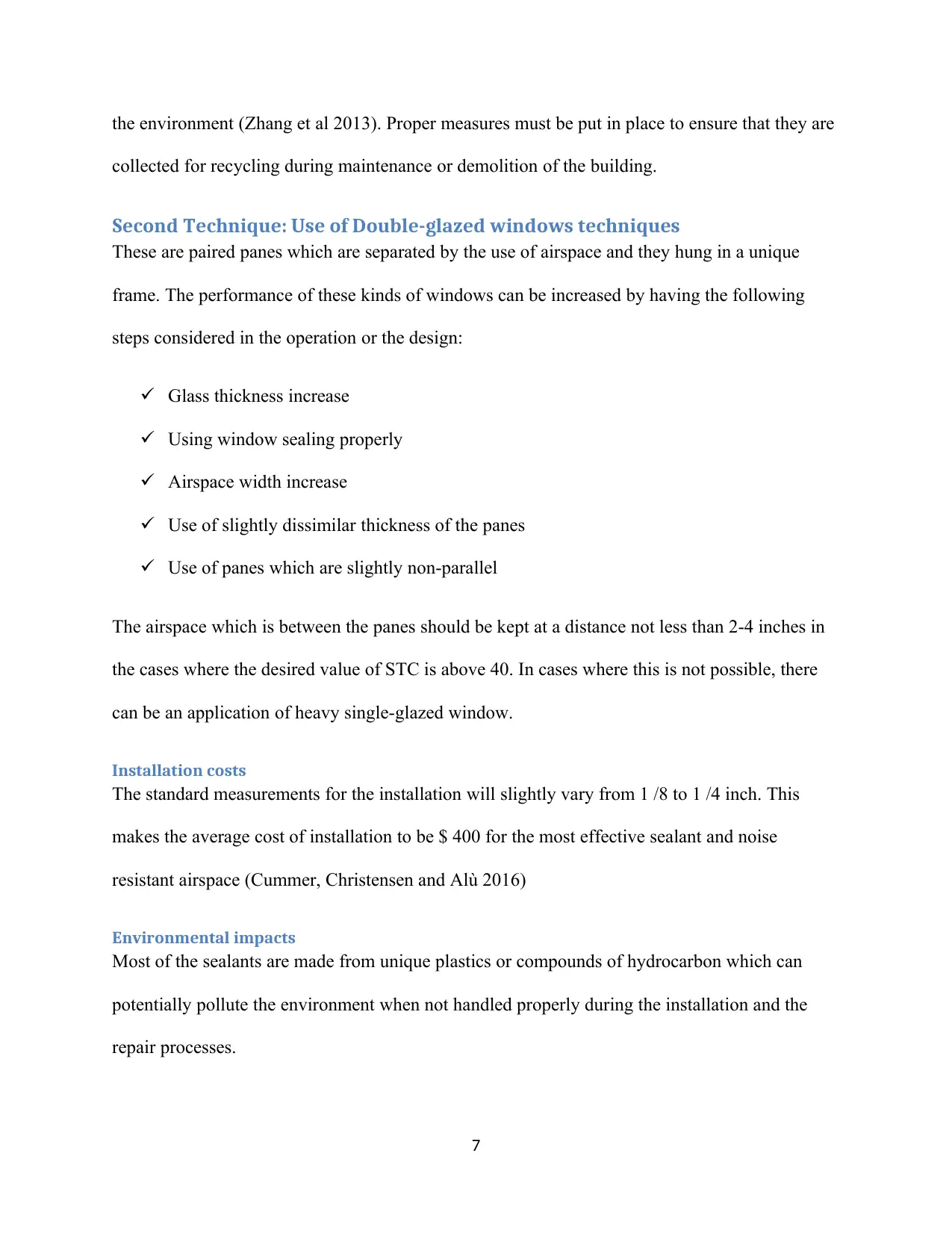
the environment (Zhang et al 2013). Proper measures must be put in place to ensure that they are
collected for recycling during maintenance or demolition of the building.
Second Technique: Use of Double-glazed windows techniques
These are paired panes which are separated by the use of airspace and they hung in a unique
frame. The performance of these kinds of windows can be increased by having the following
steps considered in the operation or the design:
Glass thickness increase
Using window sealing properly
Airspace width increase
Use of slightly dissimilar thickness of the panes
Use of panes which are slightly non-parallel
The airspace which is between the panes should be kept at a distance not less than 2-4 inches in
the cases where the desired value of STC is above 40. In cases where this is not possible, there
can be an application of heavy single-glazed window.
Installation costs
The standard measurements for the installation will slightly vary from 1 /8 to 1 /4 inch. This
makes the average cost of installation to be $ 400 for the most effective sealant and noise
resistant airspace (Cummer, Christensen and Alù 2016)
Environmental impacts
Most of the sealants are made from unique plastics or compounds of hydrocarbon which can
potentially pollute the environment when not handled properly during the installation and the
repair processes.
7
collected for recycling during maintenance or demolition of the building.
Second Technique: Use of Double-glazed windows techniques
These are paired panes which are separated by the use of airspace and they hung in a unique
frame. The performance of these kinds of windows can be increased by having the following
steps considered in the operation or the design:
Glass thickness increase
Using window sealing properly
Airspace width increase
Use of slightly dissimilar thickness of the panes
Use of panes which are slightly non-parallel
The airspace which is between the panes should be kept at a distance not less than 2-4 inches in
the cases where the desired value of STC is above 40. In cases where this is not possible, there
can be an application of heavy single-glazed window.
Installation costs
The standard measurements for the installation will slightly vary from 1 /8 to 1 /4 inch. This
makes the average cost of installation to be $ 400 for the most effective sealant and noise
resistant airspace (Cummer, Christensen and Alù 2016)
Environmental impacts
Most of the sealants are made from unique plastics or compounds of hydrocarbon which can
potentially pollute the environment when not handled properly during the installation and the
repair processes.
7
Paraphrase This Document
Need a fresh take? Get an instant paraphrase of this document with our AI Paraphraser
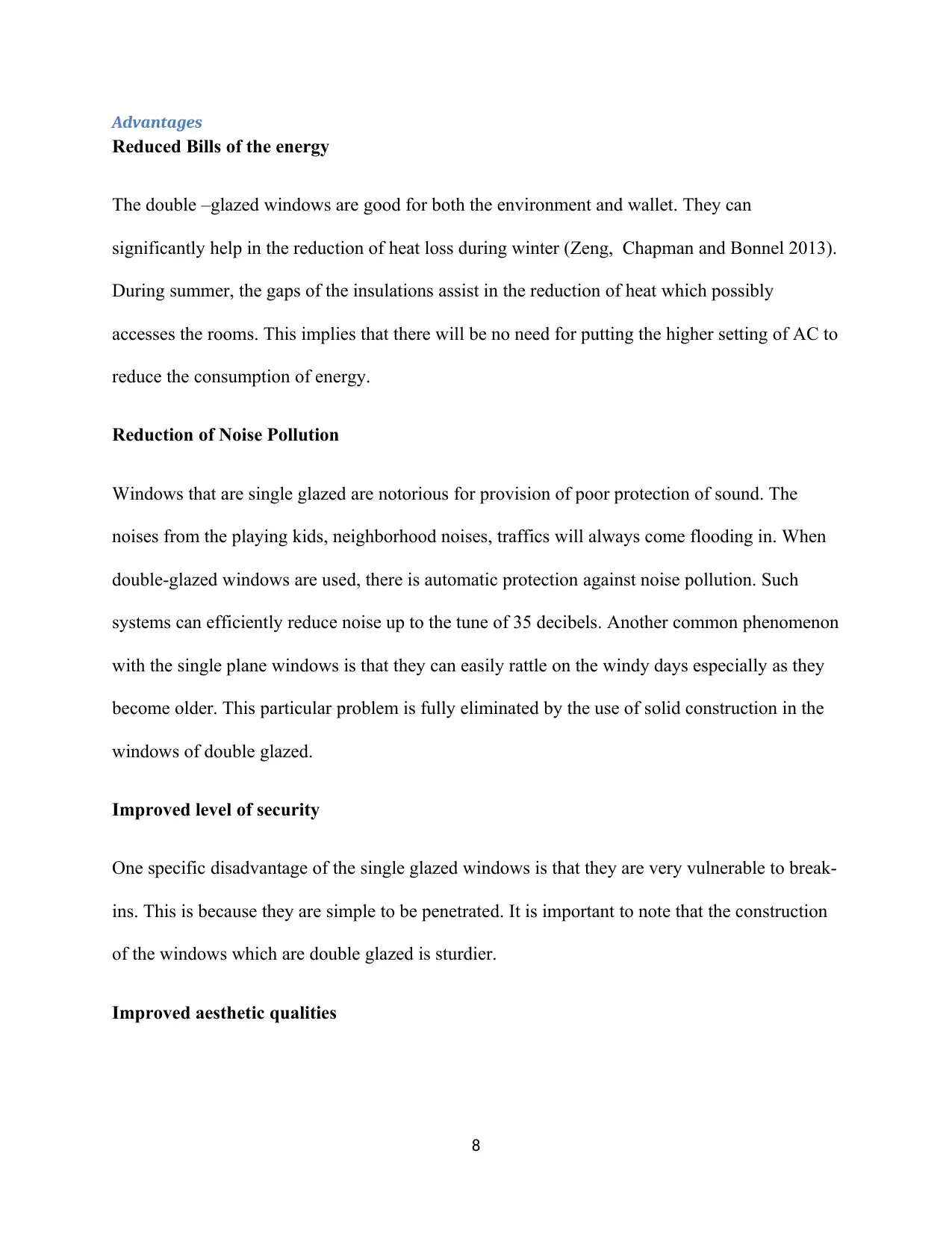
Advantages
Reduced Bills of the energy
The double –glazed windows are good for both the environment and wallet. They can
significantly help in the reduction of heat loss during winter (Zeng, Chapman and Bonnel 2013).
During summer, the gaps of the insulations assist in the reduction of heat which possibly
accesses the rooms. This implies that there will be no need for putting the higher setting of AC to
reduce the consumption of energy.
Reduction of Noise Pollution
Windows that are single glazed are notorious for provision of poor protection of sound. The
noises from the playing kids, neighborhood noises, traffics will always come flooding in. When
double-glazed windows are used, there is automatic protection against noise pollution. Such
systems can efficiently reduce noise up to the tune of 35 decibels. Another common phenomenon
with the single plane windows is that they can easily rattle on the windy days especially as they
become older. This particular problem is fully eliminated by the use of solid construction in the
windows of double glazed.
Improved level of security
One specific disadvantage of the single glazed windows is that they are very vulnerable to break-
ins. This is because they are simple to be penetrated. It is important to note that the construction
of the windows which are double glazed is sturdier.
Improved aesthetic qualities
8
Reduced Bills of the energy
The double –glazed windows are good for both the environment and wallet. They can
significantly help in the reduction of heat loss during winter (Zeng, Chapman and Bonnel 2013).
During summer, the gaps of the insulations assist in the reduction of heat which possibly
accesses the rooms. This implies that there will be no need for putting the higher setting of AC to
reduce the consumption of energy.
Reduction of Noise Pollution
Windows that are single glazed are notorious for provision of poor protection of sound. The
noises from the playing kids, neighborhood noises, traffics will always come flooding in. When
double-glazed windows are used, there is automatic protection against noise pollution. Such
systems can efficiently reduce noise up to the tune of 35 decibels. Another common phenomenon
with the single plane windows is that they can easily rattle on the windy days especially as they
become older. This particular problem is fully eliminated by the use of solid construction in the
windows of double glazed.
Improved level of security
One specific disadvantage of the single glazed windows is that they are very vulnerable to break-
ins. This is because they are simple to be penetrated. It is important to note that the construction
of the windows which are double glazed is sturdier.
Improved aesthetic qualities
8
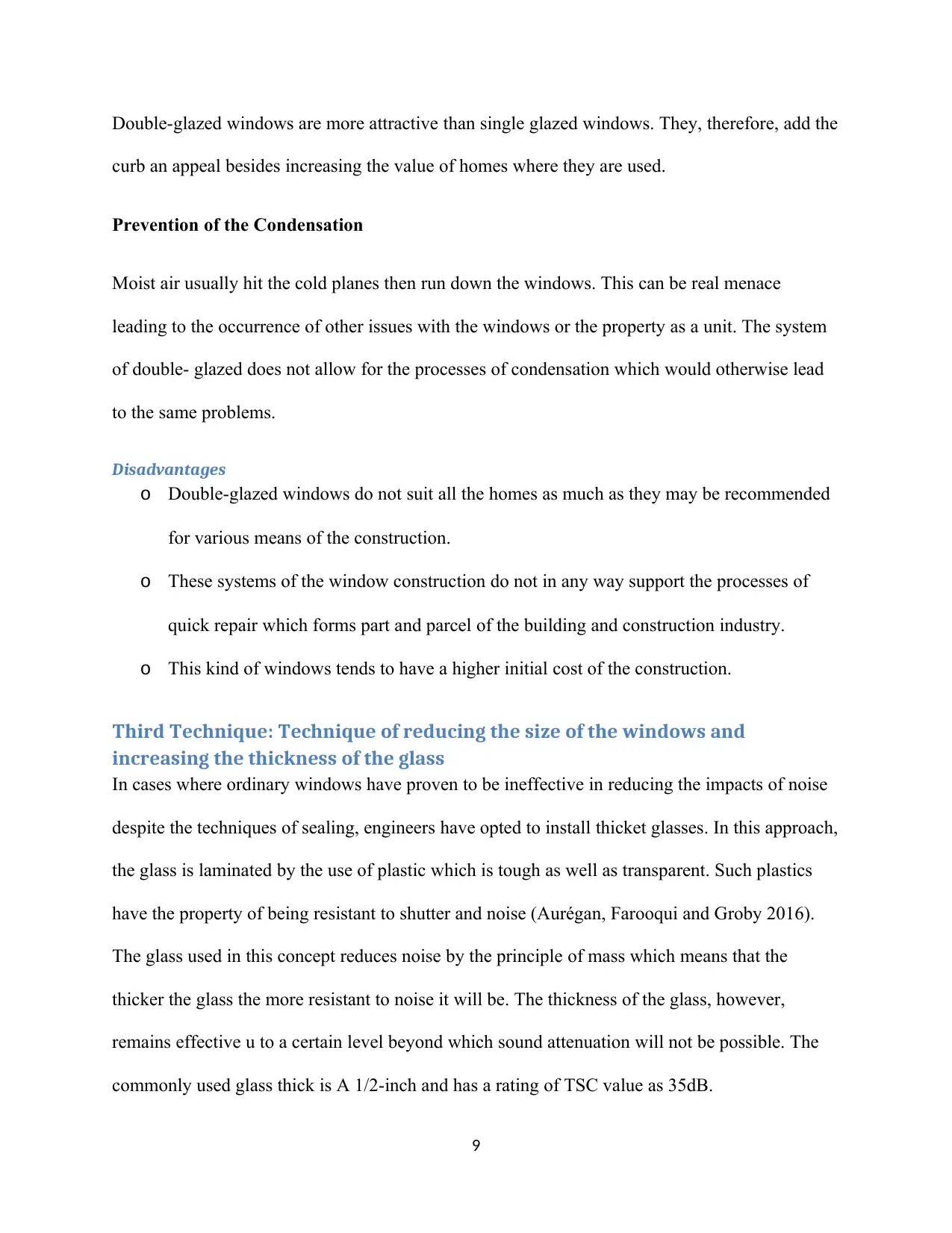
Double-glazed windows are more attractive than single glazed windows. They, therefore, add the
curb an appeal besides increasing the value of homes where they are used.
Prevention of the Condensation
Moist air usually hit the cold planes then run down the windows. This can be real menace
leading to the occurrence of other issues with the windows or the property as a unit. The system
of double- glazed does not allow for the processes of condensation which would otherwise lead
to the same problems.
Disadvantages
o Double-glazed windows do not suit all the homes as much as they may be recommended
for various means of the construction.
o These systems of the window construction do not in any way support the processes of
quick repair which forms part and parcel of the building and construction industry.
o This kind of windows tends to have a higher initial cost of the construction.
Third Technique: Technique of reducing the size of the windows and
increasing the thickness of the glass
In cases where ordinary windows have proven to be ineffective in reducing the impacts of noise
despite the techniques of sealing, engineers have opted to install thicket glasses. In this approach,
the glass is laminated by the use of plastic which is tough as well as transparent. Such plastics
have the property of being resistant to shutter and noise (Aurégan, Farooqui and Groby 2016).
The glass used in this concept reduces noise by the principle of mass which means that the
thicker the glass the more resistant to noise it will be. The thickness of the glass, however,
remains effective u to a certain level beyond which sound attenuation will not be possible. The
commonly used glass thick is A 1/2-inch and has a rating of TSC value as 35dB.
9
curb an appeal besides increasing the value of homes where they are used.
Prevention of the Condensation
Moist air usually hit the cold planes then run down the windows. This can be real menace
leading to the occurrence of other issues with the windows or the property as a unit. The system
of double- glazed does not allow for the processes of condensation which would otherwise lead
to the same problems.
Disadvantages
o Double-glazed windows do not suit all the homes as much as they may be recommended
for various means of the construction.
o These systems of the window construction do not in any way support the processes of
quick repair which forms part and parcel of the building and construction industry.
o This kind of windows tends to have a higher initial cost of the construction.
Third Technique: Technique of reducing the size of the windows and
increasing the thickness of the glass
In cases where ordinary windows have proven to be ineffective in reducing the impacts of noise
despite the techniques of sealing, engineers have opted to install thicket glasses. In this approach,
the glass is laminated by the use of plastic which is tough as well as transparent. Such plastics
have the property of being resistant to shutter and noise (Aurégan, Farooqui and Groby 2016).
The glass used in this concept reduces noise by the principle of mass which means that the
thicker the glass the more resistant to noise it will be. The thickness of the glass, however,
remains effective u to a certain level beyond which sound attenuation will not be possible. The
commonly used glass thick is A 1/2-inch and has a rating of TSC value as 35dB.
9
⊘ This is a preview!⊘
Do you want full access?
Subscribe today to unlock all pages.

Trusted by 1+ million students worldwide
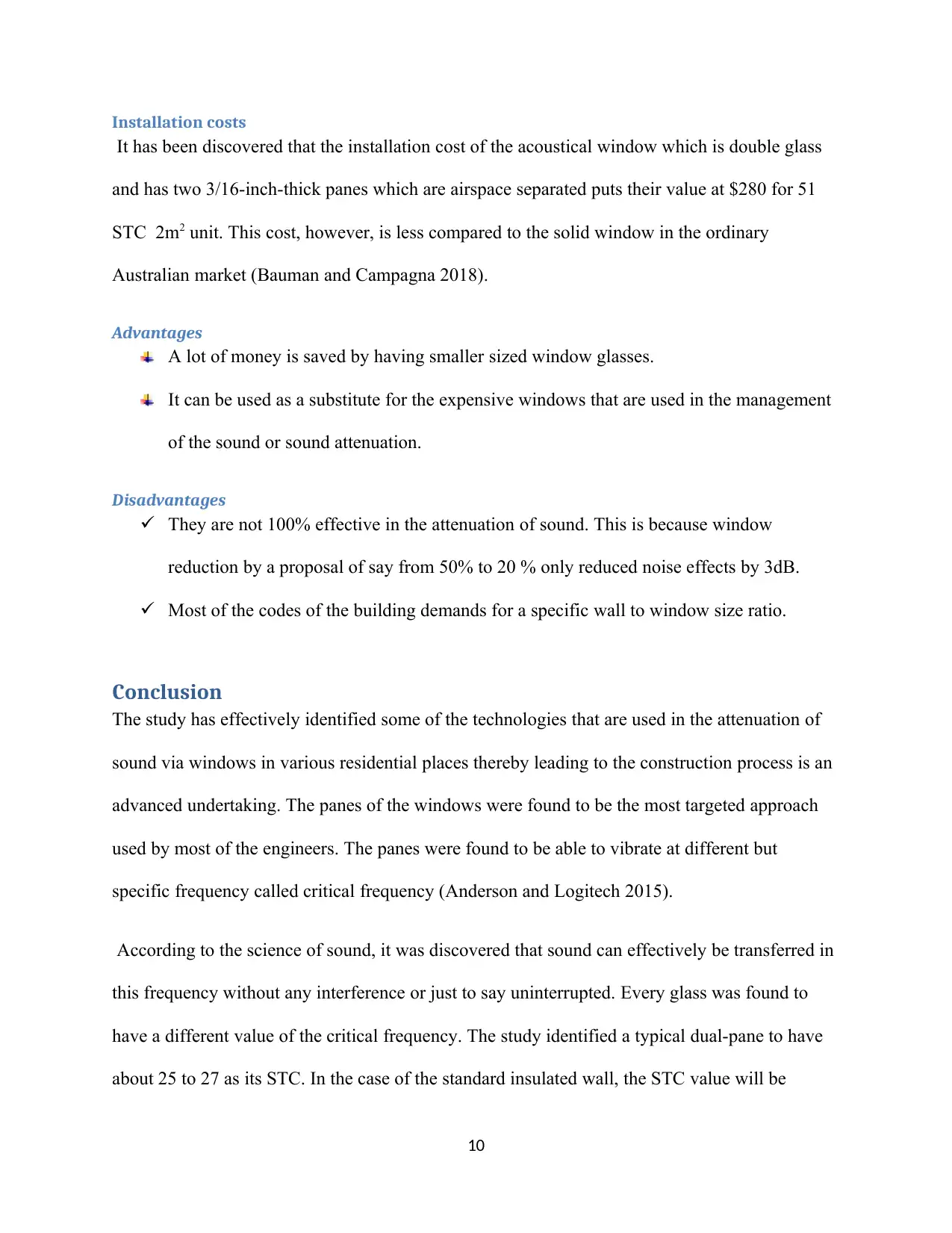
Installation costs
It has been discovered that the installation cost of the acoustical window which is double glass
and has two 3/16-inch-thick panes which are airspace separated puts their value at $280 for 51
STC 2m2 unit. This cost, however, is less compared to the solid window in the ordinary
Australian market (Bauman and Campagna 2018).
Advantages
A lot of money is saved by having smaller sized window glasses.
It can be used as a substitute for the expensive windows that are used in the management
of the sound or sound attenuation.
Disadvantages
They are not 100% effective in the attenuation of sound. This is because window
reduction by a proposal of say from 50% to 20 % only reduced noise effects by 3dB.
Most of the codes of the building demands for a specific wall to window size ratio.
Conclusion
The study has effectively identified some of the technologies that are used in the attenuation of
sound via windows in various residential places thereby leading to the construction process is an
advanced undertaking. The panes of the windows were found to be the most targeted approach
used by most of the engineers. The panes were found to be able to vibrate at different but
specific frequency called critical frequency (Anderson and Logitech 2015).
According to the science of sound, it was discovered that sound can effectively be transferred in
this frequency without any interference or just to say uninterrupted. Every glass was found to
have a different value of the critical frequency. The study identified a typical dual-pane to have
about 25 to 27 as its STC. In the case of the standard insulated wall, the STC value will be
10
It has been discovered that the installation cost of the acoustical window which is double glass
and has two 3/16-inch-thick panes which are airspace separated puts their value at $280 for 51
STC 2m2 unit. This cost, however, is less compared to the solid window in the ordinary
Australian market (Bauman and Campagna 2018).
Advantages
A lot of money is saved by having smaller sized window glasses.
It can be used as a substitute for the expensive windows that are used in the management
of the sound or sound attenuation.
Disadvantages
They are not 100% effective in the attenuation of sound. This is because window
reduction by a proposal of say from 50% to 20 % only reduced noise effects by 3dB.
Most of the codes of the building demands for a specific wall to window size ratio.
Conclusion
The study has effectively identified some of the technologies that are used in the attenuation of
sound via windows in various residential places thereby leading to the construction process is an
advanced undertaking. The panes of the windows were found to be the most targeted approach
used by most of the engineers. The panes were found to be able to vibrate at different but
specific frequency called critical frequency (Anderson and Logitech 2015).
According to the science of sound, it was discovered that sound can effectively be transferred in
this frequency without any interference or just to say uninterrupted. Every glass was found to
have a different value of the critical frequency. The study identified a typical dual-pane to have
about 25 to 27 as its STC. In the case of the standard insulated wall, the STC value will be
10
Paraphrase This Document
Need a fresh take? Get an instant paraphrase of this document with our AI Paraphraser

between 35 and 42. This implies that the STC value for the best sound control and pros value
should be as close as possible.
11
should be as close as possible.
11

12
⊘ This is a preview!⊘
Do you want full access?
Subscribe today to unlock all pages.

Trusted by 1+ million students worldwide
1 out of 15
Related Documents
Your All-in-One AI-Powered Toolkit for Academic Success.
+13062052269
info@desklib.com
Available 24*7 on WhatsApp / Email
![[object Object]](/_next/static/media/star-bottom.7253800d.svg)
Unlock your academic potential
Copyright © 2020–2025 A2Z Services. All Rights Reserved. Developed and managed by ZUCOL.



